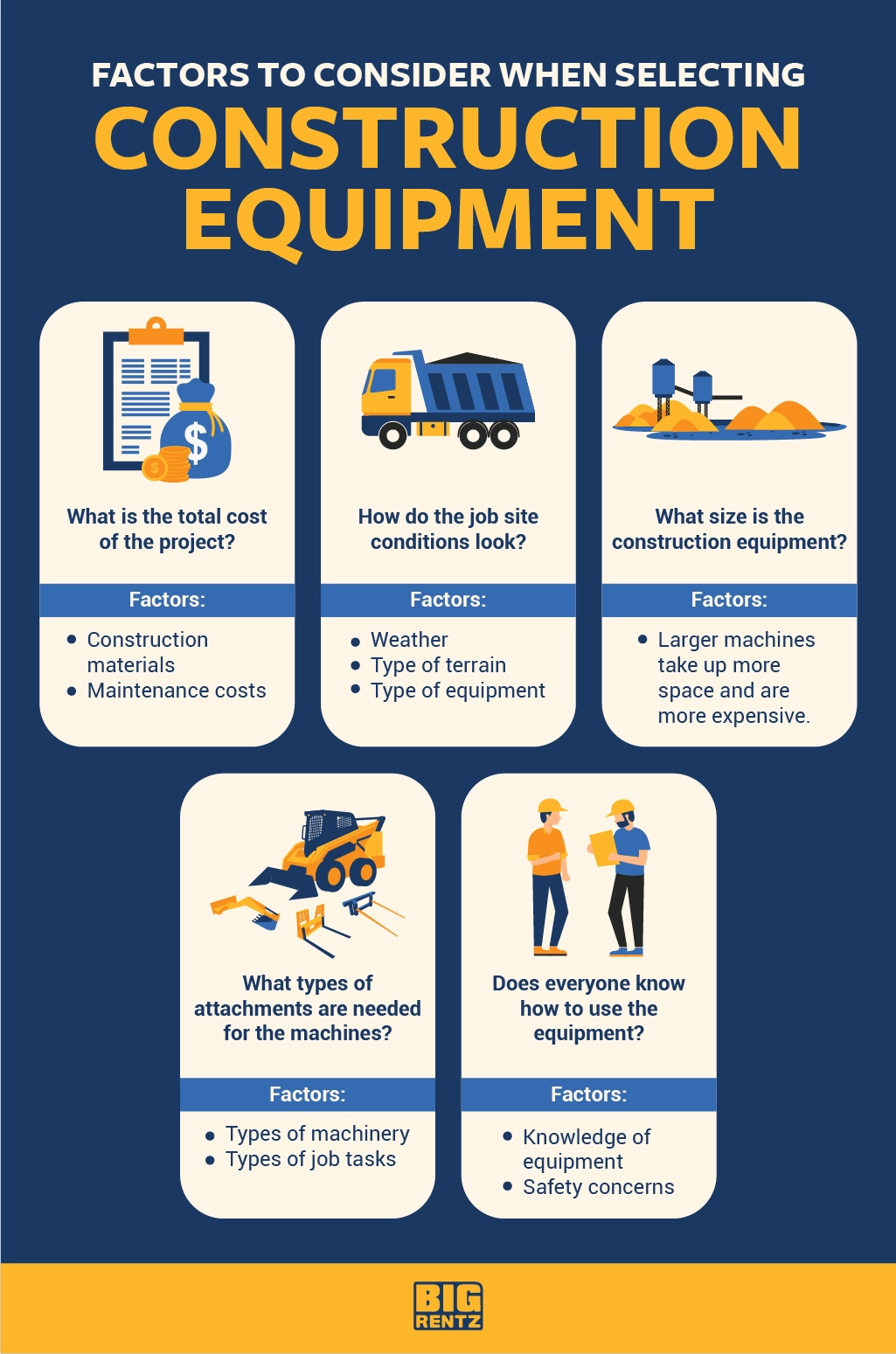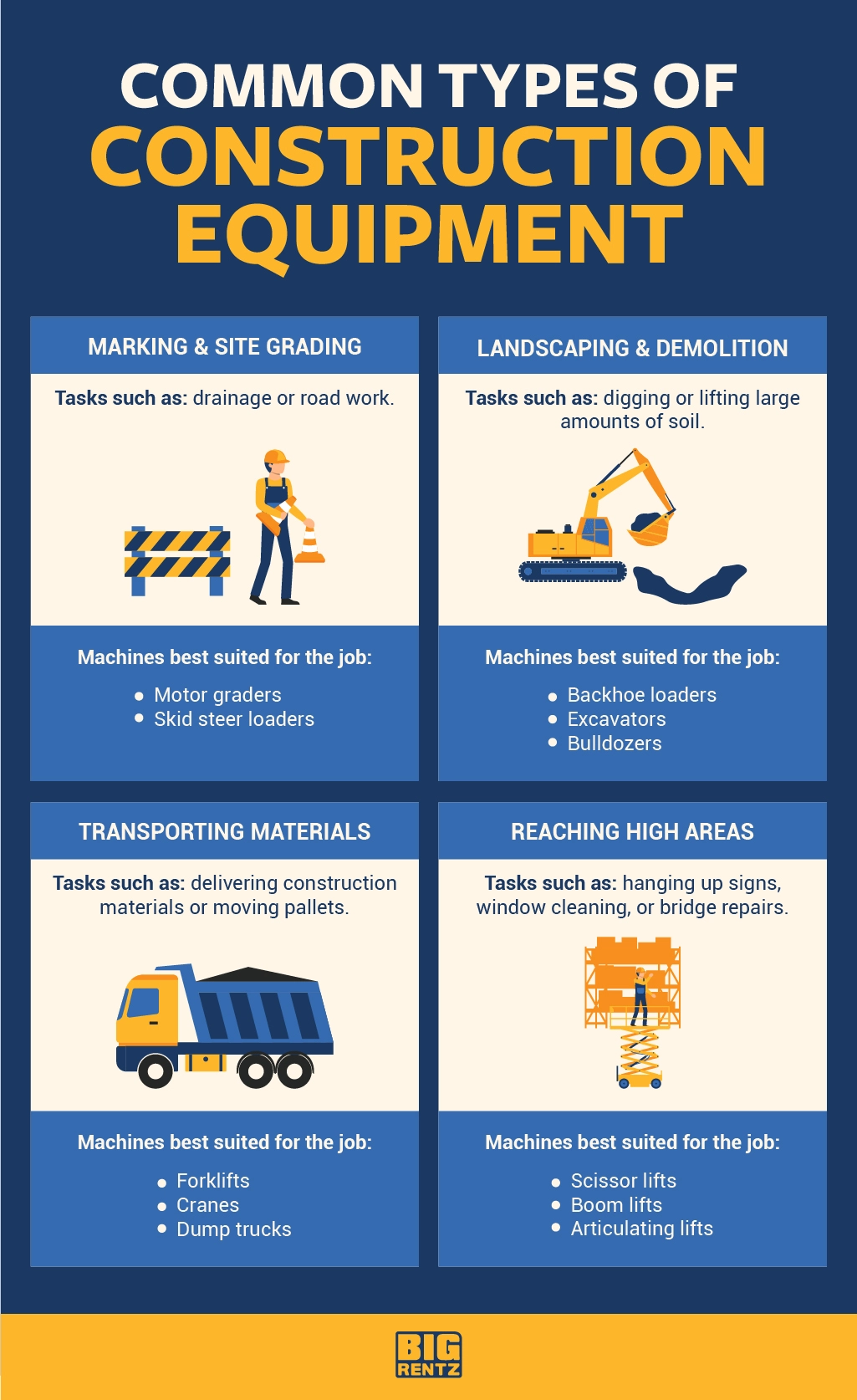Before beginning a project, you need to identify your equipment needs. From scrapers and graders to telehandlers and scissor lifts, there’s an array of equipment to help complete any project, large or small. Use our guide to assess your needs and select the right equipment for your upcoming project.
Factors to Consider When Selecting Construction Equipment

Your plans require equipment that meets your job site, goals, and budget. Keep the following factors in mind when creating a checklist of what you need.
Cost and Scope of Project
Consider the cost of the overall project. Each piece of equipment you need adds to your bottom-line cost, so versatility and adaptability (in terms of available attachments) can be key. Think about potential costs such as:
- Fuel consumption
- Construction materials
- Equipment
- Wages/labor costs for workers
- Maintenance of equipment
- Utilities and transportation
- Financing (taxes, fees, insurance)
The Job Site Conditions
Take a look at the construction site to assess the scope of the project and site conditions. Does your project involve a big job site or a small indoor area? Do you see a number of obstacles you need to maneuver around in tight quarters, such as utility lines, structures you plan to leave in place, or other pieces of equipment?
Consider job conditions such as:
- Weather
- Terrain
- The type of equipment that will be used
- The type of landscaping work you’re planning
The availability of spare parts can affect project goals. Be aware of what you have at your disposal at the worksite so that you can be sure about what to buy, how long the tools last, and how much you need to budget. If you encounter a shortage of tools, you may face more downtime between sessions waiting for the tools to come. This can drive up costs further and put deadlines in jeopardy.
Issues that may arise include:
- Shortage of construction materials
- Damage to or reuse of materials
- Leftover waste from construction materials
Size of Construction Equipment
Equipment size should be a factor in your selection of construction equipment. Heavy construction equipment can take more space at a job site, creating crowded conditions that increase safety risks and make maneuvering more difficult. On the other hand, you may need larger equipment such as telescopic boom lifts or wheel loaders to get the job done.
Of course, a larger piece of equipment uses more fuel and could emit more fumes at your worksite. You may need large machines, such as excavators, backhoes, skid steers, or forklifts. Many are powered by diesel engines, but some are also available in electric models that run more quietly and don’t give off exhaust, thus improving working conditions. Ideal for indoor spaces such as warehouses, electric models can also be used outdoors.
Available Attachments
Attachments can be an important part of your construction project because they allow you to use the same piece of equipment for a variety of different tasks. Skid steers, for example, can be equipped with attachments for boring holes, digging trenches, plowing snow, clearing brush, spearing bales of hay, and a variety of other tasks.
Attachments can expand what you can do with less equipment and can open up your job site, as well. If you end up needing a skid steer, excavator, or tractor for a specific task, you should look at what attachment to use to complete that task. A few to consider include:
- Augers: For digging precise holes
- Grapple buckets: For picking up and gripping material as you go
- Mulchers: For chopping up vegetation and brush
- Rakes: For uprooting plants and clearing brush
- Blades: For grading, leveling, and removing soil, rocks, snow, and more
Required Training and Certification
Consider how much experience you have with the equipment and what type of training your or your crew needs beforehand. For example, some construction vehicles (excavators and cranes) require certification to operate. If you don’t know how to use a piece of equipment properly, it could cost you time and money. The equipment might break if used improperly or not maintained.
Many pieces of equipment come with safety features, such as emergency stop buttons, handrails, and more. You should know how to use them properly so safety issues don’t arise.
The Best Equipment for Common Construction Projects

Depending on the nature of a project, you can find a variety of speciality equipment and standard equipment at a worksite. Important tasks at most construction jobs include clearing, grading, lifting, and moving. Depending on how big and/or cluttered your job site is and how high you have to reach, you may need several different pieces of heavy equipment.
Marking and Site Grading
During the planning portion of the project, you need to mark the area of the plot for reference and then begin grading.
Machines Best for Grading:
- Motor graders: Building roads and grading surfaces
- Skid steer loaders: Earthmoving tasks like digging, trenching, and excavating
Landscaping and Demolition
This portion of the project usually involves restructuring the terrain and environment. It includes tasks such as demolition, digging into the soil, and creating spaces to make ponds, fences, gardens, or other features/structures.
Machines Best for Landscaping:
- Backhoe Loaders: Digging up holes for ponds, fences, or trenches
- Excavators: Demolition tasks or lifting heavy amounts of soil off the ground
- Bulldozers: Pushing, digging, and excavating materials like boulders or stumps
- Wheel loaders: Building roads or digging
Transporting Materials
During this stage of a construction project, you usually move materials around the worksite, remove them from a job site, or transfer them to a warehouse.
Machines Best for Transportation:
- Forklifts: Best for lifting and moving materials such as pallets and crates over short distances
- Cranes: Best for lifting and carrying heavy materials for bridges or buildings
- Dump trucks: Best for carrying loads of materials away from or onto construction sites
Reaching High Areas
If you’re building or renovating a tall structure, you need a way to reach the place where you’re working. To do so, you have several options, depending on how high you want to go, how many obstacles and tight spaces you’re facing, and how much material or how many workers you need to lift.
Machines Best for Reaching High Areas:
- Scissor lifts: For tasks such as hanging signs, these can be raised or lowered vertically and can accommodate more workers and/or material on their larger platforms.
- Telescopic boom lifts: Lifts that expand and retract like a telescope, you can use these to lift people to higher areas.
- Articulating boom lifts: Accessing hard-to-reach areas, their jointed arms can move workers around obstacles and over walls.
Renting vs. Purchasing Equipment
If you know you need to use a specific piece of equipment repeatedly on multiple jobs, it can make sense to purchase it. However, renting can be a better option if you only need it for one specific job or you need different sized equipment for different jobs.
If You Rent:
Not only is renting equipment cheaper than purchasing, you also don’t have to worry about where to store it or maintenance costs. Plus, equipment wears out eventually, and you have to pay to replace it when it does. With a rental, on the other hand, you just need to make sure you return it in good condition.
In the long run, you can save substantially when you compare costs to those associated with purchasing. For example, you can rent a boom lift for $250 to $400 a day. A skid steer rental may run you $248 a day or $676 a week to start.
If You Purchase:
Buying construction equipment means making a long-term investment. So you should be sure the machinery is worth the investment and can be used time and again before you lay out tens of thousands of dollars on a piece of equipment.
For instance, a 30-40 foot boom lift can cost between $25,000 and $75,000. A Bobcat skid steer, meanwhile, can cost $25,000 to $65,000.
Need to Rent Out Equipment?
If you would like to rent specific equipment, then check out BigRentz for a large selection of boom lifts, loaders, dozers, and other kinds of equipment. You’re sure to find what you need for any construction project, indoor or outdoor, large or small.